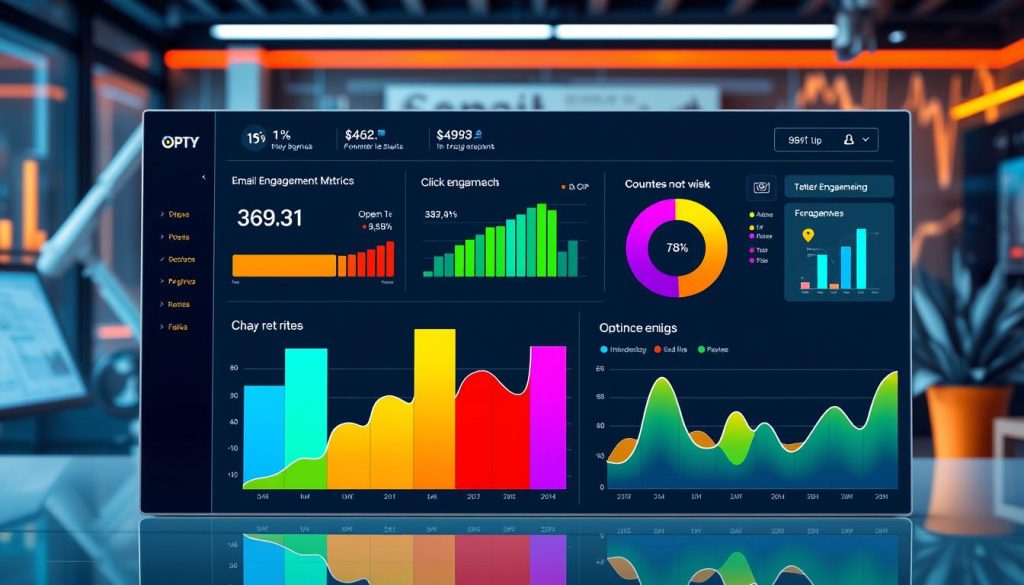Email is still a key tool in digital marketing for reaching out to potential customers. But, getting your emails delivered can be tough. Domain warming is a smart way to boost your email success.
Domain warming means slowly sending more emails from a new domain or IP. This helps build a good reputation with email service providers (ESPs). It keeps your emails out of the spam folder by avoiding bad sender reputation.
Key Takeaways
- Domain warming is a critical step in building a successful email marketing strategy.
- Establishing a positive sender reputation is key to ensuring high email deliverability.
- A gradual warmup process helps you avoid the negative impacts of poor sender reputation.
- Integrating domain warming into your overall email marketing plan can significantly improve cold email campaign success.
- Monitoring and optimizing email engagement metrics is essential for maintaining a warm domain.
What is Domain Warming?
Domain warming is key in email marketing. It’s about slowly building your email domain’s reputation. This is vital to make sure your emails reach your recipients’ inboxes, not the spam folder.
Understanding the Importance of a Gradual Warmup
Email providers like Gmail, Yahoo, and Outlook watch how you send emails. They look at open rates, click-through rates, and bounce rates. This helps them decide if your domain is trustworthy.
A sudden burst of emails from a new domain can be a problem. It might make your emails look like spam.
The Impact of Poor Sender Reputation on Email Deliverability
A bad sender reputation can hurt your email delivery. Your messages might go straight to the spam folder. This makes it hard to reach your audience.
It also hurts your email marketing campaigns and email infrastructure optimization.
By slowly warming up your domain, you can improve your sender reputation. This means more of your emails will reach the inbox. You should send more emails over time but keep your engagement high.
“Effective domain warming is the foundation for successful email deliverability and campaign performance.”
IP Warming: The First Step to a Successful Email Campaign
In email marketing, IP warming is key to a successful campaign. It’s about building a good reputation for your email system. This is crucial for getting your cold emails delivered.
Starting with a new IP address, ESPs know little about you. This can make them think your emails are spam. This hurts your email delivery and campaign success.
Through IP warming, you build trust with ESPs. You show your emails are real and valuable. This means slowly sending more emails and keeping high engagement and a clean sender reputation.
The Benefits of IP Warming
- Improved email deliverability: A good sender reputation means more emails reach inboxes.
- Enhanced email infrastructure optimization: IP warming makes your email campaigns run better.
- Increased email engagement: Better deliverability means more opens and clicks.
Starting with IP warming is vital for a good email marketing plan. Spending time to warm your IP address sets up your email success. It leads to better deliverability and more effective campaigns.
“IP warming is the key to unlocking the full potential of your email marketing efforts. It’s the foundation upon which you can build a thriving, high-performing email program.”
| IP Warming Best Practices | Benefits |
|---|---|
| Start with a low email volume and gradually increase over time | Establishes a positive sender reputation with ESPs |
| Maintain high engagement rates (open, click-through, and conversion) | Demonstrates the value of your emails to recipients |
| Consistently monitor your email metrics and make adjustments as needed | Ensures the ongoing optimization of your email infrastructure |
Building Trust Through Email Authentication
In the world of email marketing, it’s key to build trust with both email service providers and recipients. This is where SPF, DKIM, and DMARC come in. These protocols not only boost email deliverability but also improve your sender reputation. This ensures your messages land in the right inboxes.
SPF, DKIM, and DMARC: The Trio of Email Security
Sender Policy Framework (SPF) checks if the sending domain is legit, stopping spoofing and unauthorized use of your email. Domain Keys Identified Mail (DKIM) adds a digital signature to your emails, proving they’re real and untouched. Domain-based Message Authentication, Reporting, and Conformance (DMARC) links these two, creating a strong framework for email authentication and better email security.
| Protocol | Purpose | Benefits |
|---|---|---|
| SPF | Verifies the legitimacy of the sending domain | Prevents email spoofing and unauthorized use of your email address |
| DKIM | Digitally signs emails to ensure their integrity and authenticity | Enhances email security and builds trust with recipients |
| DMARC | Combines SPF and DKIM to provide a comprehensive email authentication framework | Improves overall email security and sender reputation |
Using these email authentication protocols shows email service providers and recipients that your messages are real and safe. This leads to better deliverability and more trust in your brand.
How Domain Warming Strategies Can Improve Cold Email Success
Creating a successful cold email campaign is more than just a good message. You also need to think about domain warming. This strategy can greatly increase your open and click-through rates. It also helps avoid the spam folder.
Increasing Open and Click-Through Rates
Warming up your domain helps you build a good reputation with email providers. This makes it more likely for your emails to land in the inbox instead of the spam folder. As your domain’s reputation grows, people are more likely to open and engage with your emails. This leads to higher open and click-through rates.
Avoiding the Spam Folder Trap
One big challenge with cold emailing is emails ending up in the spam folder. Domain warming reduces this risk by building a positive sending history. It also helps email providers trust you more. By following best practices for email authentication and sending emails consistently, you can make sure more of your emails reach your audience’s inboxes.
Adding domain warming strategies to your cold email campaigns can really boost success. By focusing on getting more opens and clicks, and avoiding the spam folder, you can make your outreach efforts more effective. This leads to better engagement with your potential customers.

Developing a Comprehensive Domain Warming Plan
Creating a solid domain warming plan is key for financial advisors wanting to succeed in email marketing. This plan optimizes your email infrastructure and boosts deliverability. It also helps you connect better with your audience.
To make a detailed domain warming plan, focus on these important points:
- Gradual Ramp-up: Start by sending a few emails and then slowly increase the number. This helps build your reputation and avoids triggering spam filters.
- Content Strategy: Create content that adds value and speaks to your audience. This could be educational pieces, thought-leadership articles, or personalized financial advice.
- Engagement Monitoring: Keep an eye on how your emails perform. Look at open rates, click-through rates, and bounce rates. Use this info to improve your domain warming plan and email strategy.
- Continuous Optimization: Always be looking to improve your domain warming plan. Stay up-to-date with the latest in email marketing to keep your strategy effective.
With a well-thought-out domain warming plan, financial advisors can set the stage for a successful email marketing strategy. This leads to better engagement, improved delivery rates, and stronger client bonds.
| Key Elements | Description |
|---|---|
| Gradual Ramp-up | Slowly increase email volume over time to build sender reputation and avoid triggering spam filters. |
| Content Strategy | Craft compelling, value-driven content that resonates with clients and prospects. |
| Engagement Monitoring | Closely track email engagement metrics to optimize the domain warming plan and email marketing strategy. |
| Continuous Optimization | Regularly review and refine the domain warming plan to keep up with evolving email industry trends and best practices. |
Monitoring and Optimizing Email Engagement Metrics
When you start your domain warming and cold email plans, it’s key to watch your email metrics closely. Keep an eye on open rates, click-through rates, and bounce rates. These metrics show how well your emails are doing and help you improve them.
Tracking Open Rates, Click-Through Rates, and Bounce Rates
Open rates tell you how many people are reading your emails. Click-through rates show who’s taking action, like clicking links or visiting your site. Bounce rates help spot any email delivery problems.
By watching these email engagement metrics carefully, you can tweak your emails to do better. You might change your subject lines, improve your content, or work on your sender reputation. This can help more people open and click on your emails, and send fewer emails back to you.
| Metric | Description | Benchmark |
|---|---|---|
| Open Rate | The percentage of recipients who open your email | 15-25% |
| Click-Through Rate | The percentage of recipients who click on a link in your email | 2-5% |
| Bounce Rate | The percentage of emails that are undelivered | Less than 2% |
By keeping a close eye on these email engagement metrics and making smart changes, you can keep your domain warming and cold email plans working well for your business.

Best Practices for Maintaining a Warm Domain
Keeping your domain warm is key for good email marketing. You need to focus on two main things: sending emails regularly and making content that people want to read. This helps keep your domain active and respected.
Consistent Sending Patterns
Being consistent is very important for domain warming. Sending emails too often or too little can hurt your reputation. Try to send emails at the same time every week or keep the number of emails the same.
Engaging Content and Targeted Audiences
To keep your domain warm, make content that people will enjoy. Write emails that are interesting and useful to your readers. Make sure to send emails that match what your audience likes and needs.
- Personalize your email content to each subscriber’s preferences and behavior
- Experiment with different content formats, such as educational resources, industry insights, or exclusive offers
- Monitor email engagement metrics to identify what content resonates best with your audience
By sending emails regularly and making content that people like, you can improve your reputation. This helps your email marketing do well for a long time.
Integrating Domain Warming into Your Email Marketing Strategy
Building a strong email marketing strategy needs a few key steps. Domain warming is one of them. It helps build a good reputation for your emails, making them more likely to be delivered.
Adding domain warming to your strategy makes your domain more trusted. This means your emails are more likely to land in people’s inboxes, not spam folders. Sending great content to your audience helps build a strong reputation for sending emails.
Domain warming is an ongoing effort that needs constant attention. Keep an eye on how people interact with your emails. This helps you improve your strategy and keep getting good results. See domain warming as a key part of your email marketing plan to boost your campaigns.
FAQ
What is domain warming?
Domain warming is a way to slowly increase email sending from a domain. It helps build a good reputation with email service providers (ESPs). This ensures your cold emails get to the right people.
Why is a gradual warmup process important?
A slow start is key to a good sender reputation. Sending lots of emails at once might look spammy. This could send your emails to the spam folder.
How does poor sender reputation impact email deliverability?
A bad reputation hurts your email delivery. ESPs might mark your emails as spam. This lowers open and click rates, making your campaign less effective.
What is IP warming, and how does it contribute to domain warming?
IP warming is about slowly sending more emails from a new IP. It helps build a good reputation with ESPs. This step is important for successful domain warming.
What is the role of email authentication in building trust?
Email authentication, like SPF and DKIM, builds trust with ESPs and recipients. It shows your domain is real. This helps your emails avoid being marked as spam.
How can domain warming strategies improve cold email success?
Domain warming boosts cold email success by getting more opens and clicks. It helps avoid the spam folder. A good reputation means your emails reach the right people, improving your campaign.
What are the key elements of a comprehensive domain warming plan?
A good plan includes slowly increasing email sending and creating engaging content. It also means watching and improving your email metrics for ongoing success.
Why is it important to monitor email engagement metrics?
Watching email metrics like open and click rates is crucial. It shows how well your campaigns are doing. This helps you make better choices to improve your results.
What are some best practices for maintaining a warm domain?
Keep your sending consistent and create content that interests your audience. Always be looking to improve your email strategy to keep your domain in good standing.
How can domain warming be integrated into an overall email marketing strategy?
Adding domain warming to your email strategy is key for lasting success. It helps build a good reputation and improves delivery. This leads to better cold email campaigns and a stronger email presence.


